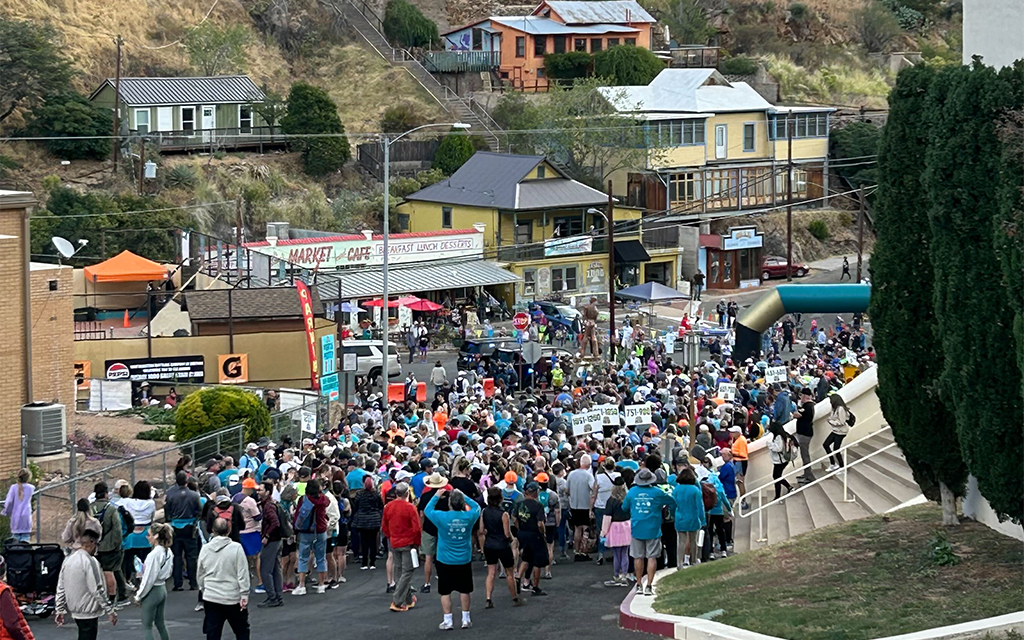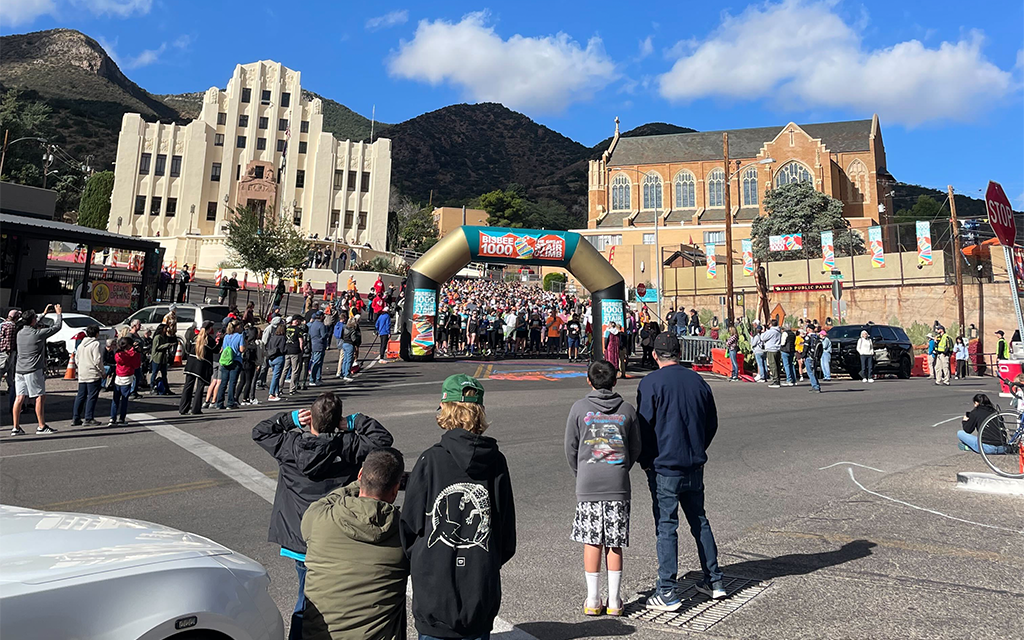BISBEE – Once the largest city between St. Louis and San Francisco with a population of about 23,000 people in the early 1900s, this once-booming mining community has transitioned into what today is a quirky artists enclave and tourist attraction.
But the town of about 5,000 tucked into the Mule Mountains not far from the U.S.-Mexico border still celebrates its rich history each year through the equally quirky Bisbee 1000: The Great Stair Climb.
It is a foot race (or walk) over a 4.5-mile course that winds through town and incorporates nine of the community’s many staircases, requiring contestants to climb more than 1,000 stairs along the way.
The stairways were once dirt paths, and later wooden stairs, used to deliver goods and ice to the homes of miners, which had to be built along steep inclines in the hilly community. The stair climb, which has been contested 33 times over the last 34 years – 2020 was canceled due to the COVID-19 pandemic – attracts participants from all over the world to the small town.
One past participant might be familiar to Phoenix sports followers.
Tom Leander, a pregame and postgame host on Phoenix Suns broadcasts, remembers the first of his two visits to Bisbee being one of the most unique experiences he has had as he walked through the town and realized it was more than just an athletic event.
“It was such a great experience the first time that I had to invite others to join me for a second time,” Leander said.
The staircases are decorated with murals and street musicians are playing along the way. The challenge doesn’t end when the final contestant crosses the finish line at Higgins Hill Park, either. There are also costume awards for those who dress in fun outfits for the race, from devil costumes to full firefighter gear.
“The competition is not the main thing there,” Leander said. “The kindness and respect that everybody had that was competing in the event stood out to me.”
It is that spirit of community that makes Bisbee such an attraction to visitors.
The town was built on the backs of immigrants from Serbia, Germany and Italy. When the Great Depression struck, concrete steps were built to replace the wooden stairs with funding from the Works Progress Administration, providing jobs for miners.
There are more than 82 staircases throughout the town, averaging 78 steps, according to “The Bisbee Stairs,” a book written by David Ryan. Many homes in Bisbee are only accessible by stairs.
Cynthia Conroy, founder of the Bisbee 100 and the nonprofit Bisbee Vogue, Inc., which continues to stage it, moved around the United States from Florida to Colorado, then to California before falling in love with Bisbee and settling here in 1987.
“We get the people who discover it somehow because of their own creative learnings,” Conroy said.
Conroy’s idea to create the Bisbee 1000 started with a bike ride. She initially lived in the Warren District about a 20 minute bike ride from the middle of town. She had biked into town to read the newspaper during the late 1980s and an article in the paper caught her attention.
“On the front page it said, ‘People are returning to the gyms,’” Conroy said. “People are returning to gyms to do the new stair climbing machines. So I said, ‘Stairs? We have stairs.’”
This prompted Conroy, with the help of friends, to create a figure-eight course that began and ended at the courthouse.
Conroy had a vision, but the course had to be designed from Bisbee’s winding streets and stairways without the aid of cell phones or Google Earth.
“There was no way to electronically figure out how this course was,” Conroy said. “So I just said, ‘It’s a 5k that feels like a 10k.’”
The inaugural event, held in 1990, had around 200 stair climbers, including some Conroy found at schools in nearby Sierra Vista, which has a population of about 45,000.
“Hey, do you want to pay $10 and do this thing?” Conroy asked at the schools.
“Well, they did pay $10, and they did it, and they had a wonderful time,” Conroy said.
To say the event grew over time would be an understatement. When the 20th annual challenge approached in 2010, over 2,000 people registered to compete, which Conroy said was too many for the course.

Over a thousand participants from around the world converge in Bisbee for the Bisbee 1000: The Great Stair Climb, a 4.5-mile challenge through the town’s historic stairways. (Photo by Keller Brown/Cronkite News)
“They had to stand in line for half an hour to get up the stairs,” Conroy said.
Many contestants return year after year, but only a few have returned as often as Tony Pellegrino, who lives in the town of Alpine in far eastern Arizona. He has participated in the last 28 Bisbee 1000 events and he has a custom shirt displaying all of the years to document it.
Pellegrino and his wife make a five-hour drive that takes them into New Mexico then back into Arizona just to take part every year. Then they make the five-hour drive back to Alpine.
Despite the drive, Pellegrino hasn’t lost motivation to climb the stairs, even if his wife and friends no longer do.
“Everybody else quit, so I’m the last guy doing it,” Pellegrino said. “I want to do it probably until I’ve done my 30th.”
Two more years, and Pellegrino will reach his goal.
The challenge has left great impressions on Pellegrino and many more, in large part due to the personality and scenery of Bisbee.
“It’s a fun place to be for the weekend,” Pellegrino said. “You get to come through the whole town of Bisbee. It’s pretty neat.”
Conroy no longer organizes the event, but her hard work continues to pay off as the Great Stair Climb goes on without her.
“No matter how hard something is, if you persevere, you will succeed,” Conroy said. “Once I persevered and it succeeded, it was too good of an event to let die with me.”


